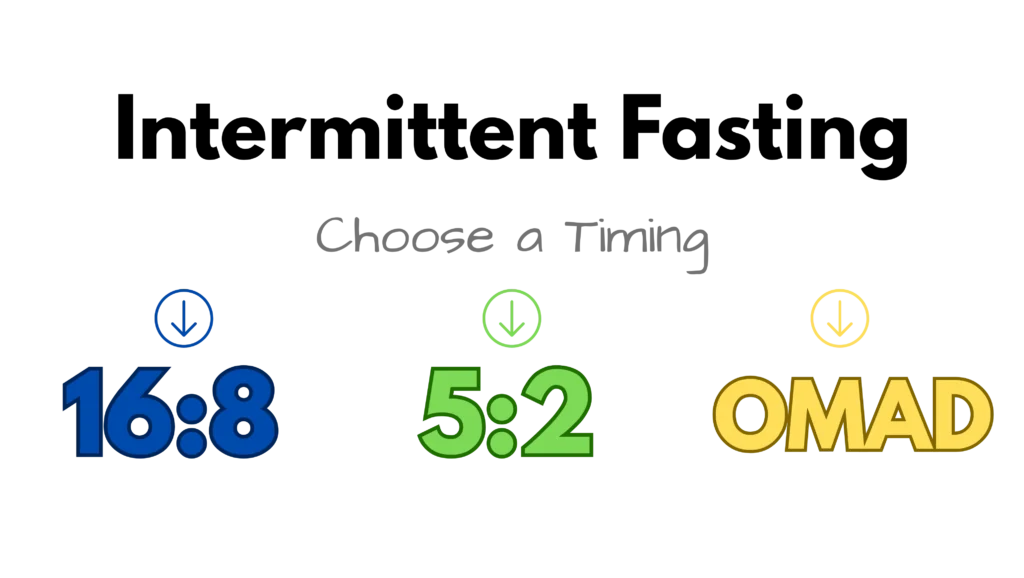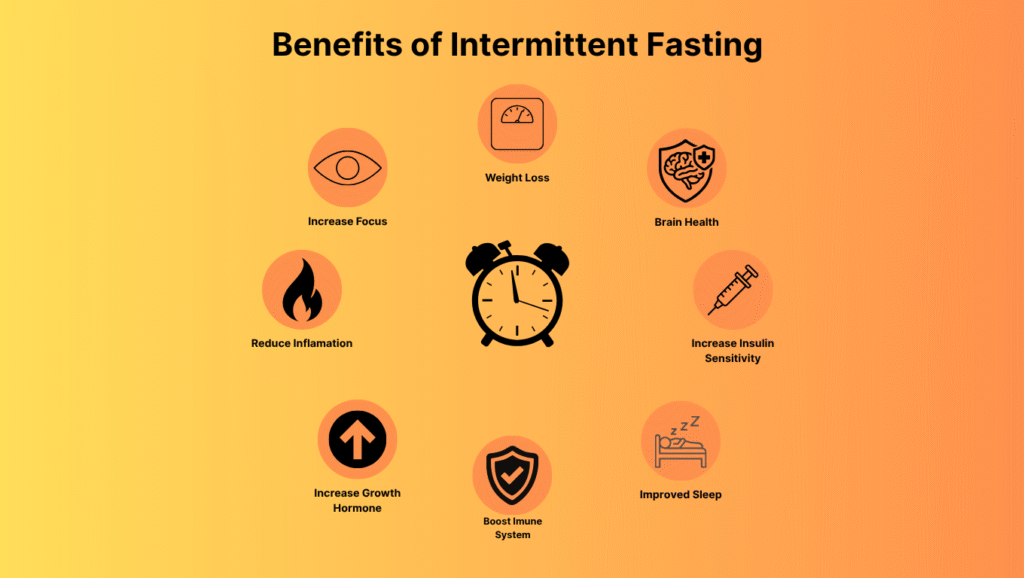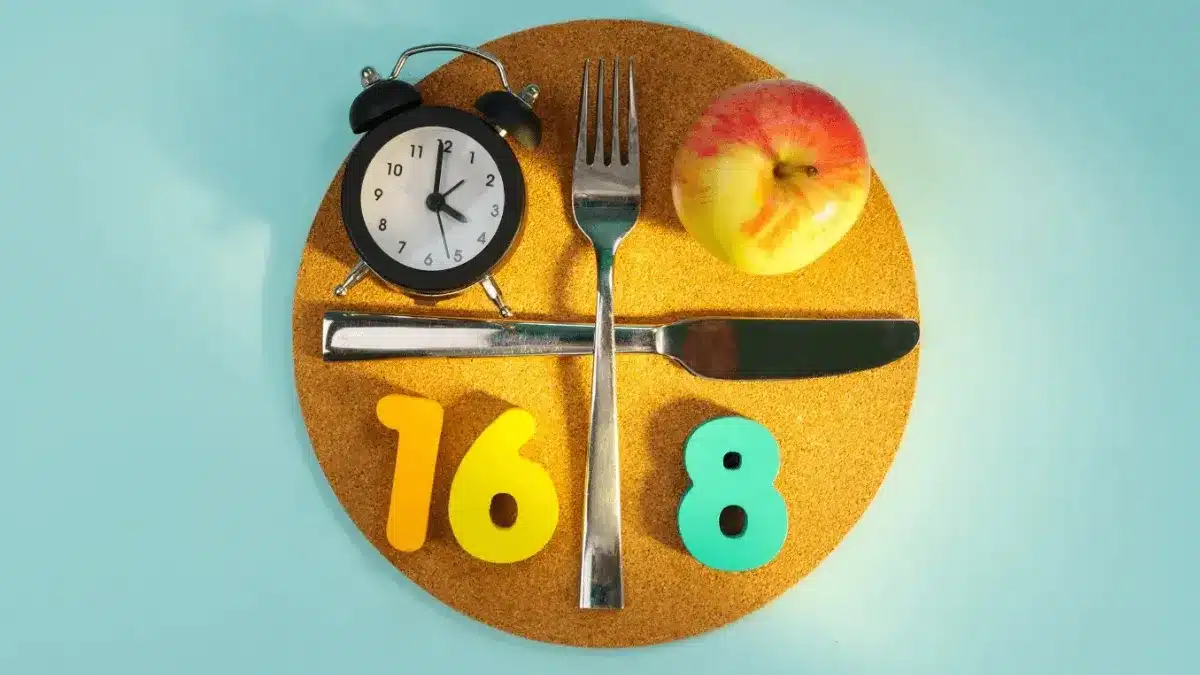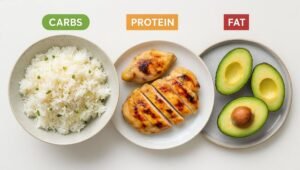Intermittent Fasting 101: Complete Beginner’s Guide [2025]
Struggling with your weight despite trying every diet? What if the solution isn’t about what you eat, but when you eat? Intermittent fasting has transformed the lives of millions by working with your body’s natural rhythms rather than against them.
Unlike traditional diets that restrict what foods you can eat, intermittent fasting focuses on when you eat. This simple shift in timing triggers powerful metabolic changes that promote fat burning, improve insulin sensitivity, and may even extend your lifespan.
Whether you’re looking to lose weight, boost energy, or improve your metabolic health, intermittent fasting offers a sustainable, science-backed approach that doesn’t require counting calories or eliminating your favorite foods.
In this comprehensive guide, you’ll discover everything you need to know about intermittent fasting for beginners, including how to start, which method to choose, and what results to expect. By the end, you’ll have a clear roadmap to begin your intermittent fasting journey with confidence.
What Is Intermittent Fasting?
Intermittent fasting is an eating pattern that cycles between periods of eating and fasting. Rather than focusing on which foods to eat or avoid, IF concentrates on when you should eat them.
This approach isn’t a diet in the traditional sense. You’re not eliminating food groups or severely restricting calories. Instead, you’re simply condensing your eating into specific time windows, allowing your body extended periods without food.
Fasting isn’t a modern invention. Humans have practiced various forms of fasting for thousands of years, both for religious and practical reasons. Our ancestors didn’t have 24-hour access to food, so the human body evolved to function effectively during periods without eating.
What makes intermittent fasting particularly appealing today is the growing body of scientific research supporting its benefits. Studies show that the timing of your meals significantly impacts your hormones, cellular function, and gene expression in ways that promote health and longevity.
The beauty of intermittent fasting lies in its simplicity. You don’t need special foods, expensive supplements, or complicated meal plans. You need to adjust when you eat.
| Traditional Eating Pattern | Intermittent Fasting Pattern |
|---|---|
| Eat throughout 12-16 hours daily | Eat within 8-10 hour window |
| Constant insulin fluctuations | Extended periods of low insulin |
| The body is always digesting food | Time for cellular repair and fat burning |
| Body is always digesting food | Fewer, more substantial meals |
What it is: Fast for 16 hours, eat within an 8-hour window.
How Intermittent Fasting Works: The Science

Understanding the metabolic changes that occur during fasting helps explain why this approach works so effectively for weight loss and health improvement.
The Metabolic Switch
Under normal eating patterns, your body primarily runs on glucose from the food you consume. Your cells use this glucose for energy, and any excess gets stored as glycogen in your liver and muscles.
When you fast for 12-16 hours, your glycogen stores become depleted. At this point, your body must switch to an alternative fuel source: stored body fat. This metabolic shift from glucose-burning to fat-burning is where intermittent fasting’s magic happens.
During this fat-burning state, your liver converts fatty acids into ketones, which serve as an efficient energy source for your body and brain. Many people report increased mental clarity and sustained energy during this phase.
The Insulin Connection
Every time you eat, your pancreas releases insulin to help transport glucose from your bloodstream into your cells. When insulin levels are high, your body remains in fat-storage mode. This makes weight loss extremely difficult, regardless of how little you eat.
What happens to insulin levels during intermittent fasting is remarkable. During fasting periods, insulin levels drop dramatically. This allows your body to access stored fat for energy, finally breaking the cycle of constant fat storage.
Lower insulin levels also improve insulin sensitivity over time. This means your cells become more responsive to insulin’s signals, requiring less of it to do the same job. Improved insulin sensitivity is crucial for preventing and reversing insulin resistance naturally.
Cellular Repair and Autophagy
Beyond fat burning and insulin regulation, fasting triggers autophagy, a cellular cleaning process. During autophagy, your cells break down and recycle old, dysfunctional proteins and cellular components.
Think of autophagy as your body’s internal recycling system. Old, damaged parts get dismantled and their components repurposed to build new, healthy cellular structures. This process may slow aging, reduce inflammation, and protect against various diseases.
Autophagy mechanisms become significantly more active after 16-24 hours of fasting. While you’ll experience some autophagy benefits with shorter fasts, longer fasting periods amplify these cellular renewal processes.
5 Popular Intermittent Fasting Methods for Beginners

Choosing the right intermittent fasting method depends on your lifestyle, schedule, and experience with fasting. Here are the five most popular approaches, arranged from easiest to most challenging.
1. The 14:10 Method (Easiest Start)
What it is: Fast for 14 hours, eat within a 10-hour window.
How it works: This method extends your overnight fast by just a few hours. For example, if you finish dinner at 7 PM, you simply wait until 9 AM for breakfast. Most of your fasting occurs while you sleep, making this the gentlest introduction to intermittent fasting.
Best for: Complete beginners, those new to fasting, and anyone wanting a gentle introduction.
Difficulty: Very Easy
2. The 16:8 Method (Most Popular)
Fasting periods dramatically lower insulin levels and improve your cells’ responsiveness to insulin. This is particularly beneficial for people with prediabetes, insulin resistance, or type 2 diabetes.
How it works: This is the most popular intermittent fasting schedule. A common approach is eating between 12 PM and 8 PM, effectively skipping breakfast. You get two substantial meals (lunch and dinner) plus snacks within your eating window.
Many people find this sustainable long term because it fits naturally into most work schedules. The morning fasting period often includes sleep, making the actual conscious fasting time manageable.
Best for: Most people, those who aren’t morning eaters, and busy professionals.
Difficulty: Easy to Moderate
3. The 5:2 Diet
What it is: Eat normally five days per week, restrict calories to 500-600 on two non-consecutive days.
How it works: Choose any two days of the week (such as Monday and Thursday) to eat only 500-600 calories. On the remaining five days, eat your normal healthy diet without calorie counting.
While not technically fasting, the severe calorie restriction on those two days produces similar metabolic effects. The advantage is flexibility; you can adjust your restricted days based on social plans or work commitments.
Best for: People who struggle with daily fasting, those with flexible schedules, and variety seekers.
Difficulty: Moderate
4. Eat-Stop-Eat
What it is: Complete 24-hour fasts once or twice per week.
How it works: Fast from dinner one day to dinner the next day (or breakfast to breakfast). For example, eat dinner at 7 PM on Monday, then don’t eat again until 7 PM on Tuesday. On non-fasting days, eat normally.
This method provides more intensive autophagy benefits but requires more discipline and experience with fasting. It’s not recommended for beginners.
Best for: Experienced fasters, those seeking maximum autophagy benefits, people comfortable with hunger.
Difficulty: Hard
5. OMAD (One Meal A Day)
What it is: Consume all daily calories within a one-hour window.
How it works: Fast for 23 hours and eat one large meal daily. This extreme form of intermittent fasting requires significant adaptation and isn’t suitable for beginners or most people long-term.
Best for: Advanced fasters only, those with specific health goals under medical supervision.
Difficulty: Very Hard
Comparison Table
| Method | Fasting Hours | Eating Window | Difficulty | Best For |
|---|---|---|---|---|
| 14:10 | 14 hours | 10 hours | Very Easy | Complete beginners |
| 16:8 | 16 hours | 8 hours | Easy | Most people |
| 5:2 | 2 days/week | 5 days normal | Moderate | Flexible schedules |
| Eat-Stop-Eat | 24 hours | 1-2x/week | Hard | Experienced fasters |
| OMAD | 23 hours | 1 hour | Very Hard | Advanced only |

9 Science-Backed Benefits of Intermittent Fasting
Research has identified numerous health benefits associated with intermittent fasting, ranging from weight loss to potential longevity effects.
1. Powerful Weight Loss and Fat Burning
Intermittent fasting helps you lose weight through multiple mechanisms. By reducing insulin levels, increasing growth hormone production, and enhancing fat-burning pathways, IF creates an optimal environment for fat loss.
Studies show intermittent fasting can lead to 3-8% weight loss over periods of 3-24 weeks. More importantly, much of this weight loss comes from stubborn belly fat rather than muscle tissue.
The beauty of IF for weight loss is that you don’t need to count calories obsessively. The restricted eating window naturally reduces calorie intake for most people. Learn more about how to control insulin for weight loss to maximize your results.
2. Improved Insulin Sensitivity
Research shows intermittent fasting can reduce fasting blood sugar by 3-6% and fasting insulin levels by 20-31%. A comprehensive study published in the journal Cell Metabolism found that time-restricted eating significantly improved insulin sensitivity and blood pressure in men with prediabetes. These improvements can help prevent or potentially reverse type 2 diabetes in some cases.
If you’re struggling with insulin resistance, combining intermittent fasting with other natural approaches to insulin sensitivity can produce remarkable results.
3. Enhanced Autophagy and Cellular Repair
During fasting, your cells initiate autophagy, breaking down and recycling old, dysfunctional proteins and cellular components. This cellular housekeeping may slow aging, reduce inflammation, and protect against diseases like cancer and Alzheimer’s.
When does autophagy start? While some autophagy occurs at shorter fasting durations, the process significantly intensifies after 16-24 hours of fasting. Many people practice longer fasts periodically specifically to maximize these autophagy benefits.
You can learn to recognize the signs of autophagy during fasting, which can help you optimize your fasting schedule.
4. Increased Human Growth Hormone
Fasting can increase growth hormone levels by up to fivefold. Human growth hormone facilitates fat burning, muscle preservation, and growth, and has numerous other metabolic benefits.
Higher HGH levels during fasting help explain why you can lose fat while preserving muscle mass, something that’s difficult to achieve with traditional caloric restriction. Understanding growth hormone and fasting can help you optimize your results.
5. Reduced Inflammation
Chronic inflammation underlies most modern diseases, from heart disease to cancer to Alzheimer’s. Studies show intermittent fasting reduces markers of inflammation throughout the body.
This anti-inflammatory effect may explain many of intermittent fasting’s health benefits, from improved joint health to reduced disease risk.
6. Better Heart Health
Intermittent fasting improves multiple risk factors for heart disease, including blood pressure, total cholesterol, LDL cholesterol, triglycerides, and inflammatory markers.
Given that heart disease remains the leading cause of death worldwide, these cardiovascular benefits make intermittent fasting a powerful preventive health tool.
7. Brain Health and Mental Clarity
Fasting increases production of brain-derived neurotrophic factor (BDNF), a protein that supports the survival of existing neurons and encourages the growth of new ones. BDNF also protects against neurodegenerative diseases.
Many people report improved focus, concentration, and mental clarity during fasting periods. This cognitive enhancement likely results from ketone production, which provides an efficient energy source for your brain.
8. Hormonal Balance and Metabolic Health
Intermittent fasting positively affects multiple hormones beyond insulin and growth hormone. It can help regulate leptin (the satiety hormone), ghrelin (the hunger hormone), and cortisol (the stress hormone).
Understanding how hormones affect weight loss helps explain why intermittent fasting succeeds where traditional diets often fail.
9. Simplified Eating and Lifestyle
Beyond the physiological benefits, intermittent fasting simplifies your daily routine. Fewer meals mean less time planning, shopping, cooking, and cleaning. Many people find this lifestyle benefit as valuable as the health improvements.
The mental freedom from constant food decisions and the financial savings from buying less food are often-overlooked advantages of the intermittent fasting lifestyle.
How to Start Intermittent Fasting: Step-by-Step Guide
Starting intermittent fasting doesn’t need to be complicated or intimidating. Follow these steps to begin your journey safely and sustainably.
Step 1: Choose Your Method
Begin with the easiest method: the 14:10 schedule. Fast for 14 hours (including sleep time) and eat within a 10-hour window. After 1-2 weeks, progress to 16:8 if you feel comfortable. Don’t jump immediately to OMAD or 24-hour fasts.
Step 2: Pick Your Eating Window
Choose an eating window that fits your lifestyle. The most popular options include:
12 PM – 8 PM: Skip breakfast, eat lunch, and dinner. This works well for people who aren’t hungry in the morning and have active evenings.
10 AM – 6 PM: Allows for a small breakfast and early dinner. Good for morning exercisers or families with early dinner schedules.
1 PM – 9 PM: For night owls who prefer later meals.
There’s no single “best” eating window. Choose what you can maintain consistently over the long term.
Step 3: Start Gradually
Week 1: Begin with a 12:12 schedule (12-hour fast, 12-hour eating window). This helps your body adjust without dramatic changes.
Week 2: Progress to 14:10.
Week 3-4: Try 16:8 if you feel ready.
Gradual adaptation minimizes side effects and increases your chances of long-term success. Rushing the process often leads to burnout and failure.
Step 4: Stay Hydrated During Fasting
Proper hydration is crucial during fasting periods. You can consume:
- Water (unlimited and encouraged)
- Black coffee (no cream, sugar, or artificial sweeteners)
- Plain tea (unsweetened, no milk)
- Sparkling water (unflavored)
Avoid anything with calories, including cream in coffee, diet sodas, or bone broth. These items trigger insulin responses and technically break your fast.
Step 5: Break Your Fast Properly
How you break your fast matters almost as much as the fast itself. Start with nutrient-dense whole foods rather than processed junk food or sugary treats.
Good first foods:
- Eggs with vegetables
- Greek yogurt with berries
- Avocado with whole-grain toast
- Salmon with leafy greens
Avoid breaking your fast with:
- Donuts, pastries, or sugary cereals
- Pizza or fast food
- Large portions of any food

Breaking your fast with high-sugar foods causes rapid insulin spikes, partially negating the benefits of your fasting period.
Step 6: What to Eat During Your Eating Window
While intermittent fasting doesn’t dictate what you eat, food quality still matters for optimal results. Understanding macronutrients and metabolism helps you make better choices.
Prioritize:
- Lean proteins (chicken, fish, eggs, legumes)
- Healthy fats (avocados, nuts, olive oil, fatty fish)
- Non-starchy vegetables (leafy greens, broccoli, peppers)
- Complex carbohydrates (quinoa, sweet potatoes, oats)
Moderate:
- Fruits (focus on berries and lower-sugar options)
- Whole grains
- Full-fat dairy
Minimize:
- Processed foods
- Refined sugars
- Trans fats
- Excessive alcohol
Learn how to count macros for beginners if you want to optimize your nutrition during eating windows.
Step 7: Listen to Your Body
Normal adaptation symptoms during the first 1-2 weeks include:
- Hunger pangs (they pass after 10-20 minutes)
- Mild fatigue
- Difficulty concentrating initially
- Irritability or mood changes
These symptoms typically resolve as your body adapts to using fat for fuel.
Warning signs that require adjustment or medical consultation:
- Extreme fatigue lasting beyond three weeks
- Dizziness, fainting, or severe lightheadedness
- Disrupted menstrual cycles (for women)
- Binge eating episodes during eating windows
- Obsessive thoughts about food are interfering with daily life
If you experience these issues, extend your eating window, reduce fasting frequency, or consult a healthcare provider.
7 Common Intermittent Fasting Mistakes to Avoid
Learning from others’ mistakes can accelerate your success and help you avoid common pitfalls.
1. Starting Too Aggressively
Many beginners try to jump immediately into OMAD or 24-hour fasts, then quit within days due to extreme hunger and fatigue. Start with 14:10, then gradually progress. Sustainable change always beats aggressive but short-lived efforts.
2. Not Drinking Enough Water
Dehydration causes headaches, fatigue, and makes hunger more intense. During fasting periods, aim for 8-10 glasses of water daily. Many perceived hunger pangs are actually thirst signals.
3. Breaking Your Fast with Junk Food
Ending a 16-hour fast with pizza, donuts, or other processed foods wastes much of your fasting effort. The insulin spike from high-sugar, high-carb foods partially negates the metabolic benefits you worked to achieve.
4. Overeating During Your Eating Window
Intermittent fasting isn’t a license to binge. While you don’t need to count every calorie obsessively, you still need reasonable portion sizes. Eating 3,000 calories in a 6-hour window can prevent weight loss despite fasting.
5. Not Getting Enough Sleep
Poor sleep disrupts hunger hormones, increases cortisol, and makes fasting significantly harder. Prioritize 7-9 hours of quality sleep nightly. Learn more about how sleep affects metabolic health and how lack of sleep affects insulin.
6. Avoiding Exercise
Light to moderate exercise complements intermittent fasting beautifully. You don’t need to avoid the gym during fasting periods. In fact, fasted workouts can enhance fat burning.
Walking is particularly effective during fasting periods. Discover how walking can lower blood sugar and support your metabolic health goals.
7. Expecting Instant Results
Intermittent fasting produces gradual but sustainable weight loss, typically 1-2 pounds per week. Expecting to lose 10 pounds in a week sets you up for disappointment. Trust the process and focus on consistency over perfection.
Who Should Not Do Intermittent Fasting?
While intermittent fasting offers numerous benefits for most people, certain individuals should avoid it or approach it with extreme caution.
Intermittent fasting is not recommended for:
- Pregnant or breastfeeding women
- Children and teenagers under 18
- People with a history of eating disorders
- Individuals with type 1 diabetes
- Those with very low body weight or a BMI under 18.5
- People taking medications require food
- Individuals with adrenal fatigue or chronic severe stress
Consult a healthcare provider before starting IF if you have:
- Type 2 diabetes, especially if taking medication
- High or low blood pressure
- History of amenorrhea (absent periods)
- Any chronic health condition requiring regular medication
- Plans for surgery or medical procedures
- A history of nutrient deficiencies
Special considerations for women:
Some women experience hormonal disruptions with aggressive intermittent fasting. Female hormones are more sensitive to perceived starvation signals. Women may do better with:
- Shorter fasting windows (14:10 rather than 16:8)
- Fasting only 3-4 days per week instead of daily
- Taking a break from fasting during the luteal phase of the menstrual cycle
- Stopping immediately if menstrual irregularities occur
Always prioritize your health over any eating protocol. If intermittent fasting doesn’t feel right for your body, there are many other approaches to improve metabolic health.
Intermittent Fasting FAQ
Can I drink coffee during intermittent fasting?
Yes, black coffee is allowed during fasting periods and may even enhance fat burning through increased metabolism. However, adding cream, milk, sugar, or artificial sweeteners breaks your fast by triggering insulin release. Stick to black coffee, or use a tiny splash of unsweetened almond milk if necessary.
Will intermittent fasting slow my metabolism?
No. Short-term fasting (16-24 hours) actually increases metabolism by 3-14% through increased norepinephrine production. According to Harvard Health Publishing, intermittent fasting may help prevent obesity and reduce the risk of associated chronic diseases, with research showing metabolic benefits rather than the metabolic slowdown seen with chronic caloric restriction. Your body only experiences metabolic slowdown with prolonged caloric restriction over many days or weeks, not with intermittent fasting schedules. Learn more about how insulin affects metabolism.
How long until I see results from intermittent fasting?
Most people notice initial results within 2-4 weeks:
- Week 1-2: Increased energy and mental clarity
- Week 2-4: Initial weight loss of 2-4 pounds
- Month 2-3: Significant fat loss and body composition changes
- Month 3+: Sustained weight loss and metabolic improvements
Can I take supplements during fasting?
It depends on the supplement:
- Allowed during fasting: Electrolytes, salt, true zero-calorie vitamins
- Breaks your fast: Fish oil, gummy vitamins, anything with calories
- Better with food: Fat-soluble vitamins (D, E, K), magnesium, multivitamins
Magnesium and metabolic health are closely linked. Take magnesium supplements during your eating window for best absorption.
Will I lose muscle with intermittent fasting?
No, when done properly. Intermittent fasting actually increases growth hormone production, which helps preserve muscle mass. To maintain muscle while fasting:
- Consume adequate protein during eating windows (0.7-1g per pound of body weight)
- Continue strength training exercises
- Don’t extend fasts beyond 24 hours regularly
- Ensure sufficient overall calorie intake
Is intermittent fasting the same as starving?
No. Starvation is an involuntary, prolonged lack of food, causing malnutrition and health decline. Intermittent fasting is controlled, voluntary, time-restricted eating with adequate nutrition during eating windows. Your body responds very differently to controlled fasting versus true starvation.
Does intermittent fasting work for women?
Yes, but women may need to adjust their approach compared to men. Female hormones are more sensitive to caloric restriction signals. Women often achieve better results with:
- Shorter daily fasts (14-16 hours instead of 18-20)
- Fasting on non-consecutive days rather than daily
- Starting more gradually
- Paying attention to menstrual cycle changes
If periods become irregular, reduce fasting intensity or frequency.
What breaks a fast?
Anything with calories technically breaks a fast:
- Any food
- Cream, milk, or sugar in beverages
- Bone broth
- Bulletproof coffee (coffee with butter/MCT oil)
- Most artificial sweeteners (debated, but best avoided)
- Diet sodas (debated, but may trigger insulin)
What doesn’t break a fast:
- Water
- Black coffee
- Plain tea (green, black, herbal)
- Sparkling water (unflavored)
Ready to Start Your Intermittent Fasting Journey?
Intermittent fasting is one of the simplest yet most effective approaches to weight loss and metabolic health. By working with your body’s natural rhythms rather than against them, IF helps you achieve sustainable results without the deprivation of traditional diets.
Your next steps:
- Start with the 14:10 method this week. Fast for 14 hours, eat within a 10-hour window.
- Choose an eating window that fits your lifestyle and commit to it for at least two weeks.
- Stay hydrated throughout your fasting periods with water, black coffee, or plain tea.
- Track your progress using a journal or fasting app to monitor how you feel and adjust as needed.
- Be patient with your body. Allow 2-3 weeks for adaptation before expecting significant results.
Remember that intermittent fasting works best when combined with other healthy lifestyle practices. Focus on eating nutritious whole foods during your eating windows, getting adequate sleep, managing stress, and staying physically active.
The key to long-term success is finding a sustainable approach that fits your lifestyle. IF shouldn’t feel like punishment or deprivation. If a particular fasting schedule doesn’t work for you, adjust it. The best intermittent fasting method is the one you can maintain consistently over time.
Continue Your Metabolic Health Journey
Related Articles:
- The Complete Guide to Insulin and Weight Loss
- Hormones, Metabolism and Weight Loss Guide
- How Sleep Affects Hormones and Weight Loss
- The 30-30-30 Rule for Weight Loss
- Leptin Resistance: Why You Can’t Lose Weight
- Natural Supplements to Help Lower Insulin
- How to Reset Your Gut for Better Health







